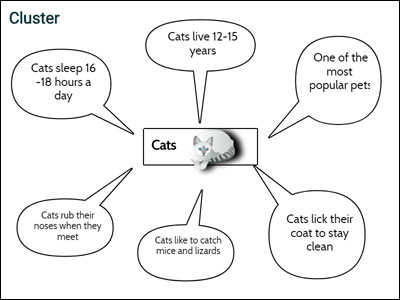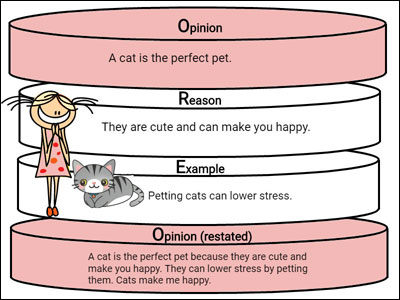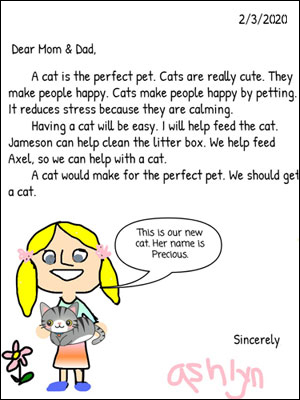Persuade for a Pet
Students write a letter to their parents, or classroom teacher, to persuade them to get a new pet, supporting their opinion with reasons and examples.

Task
Most young students love animals and many even have a pet at home. To help students think about the care a pet needs to survive and thrive, have them choose a pet they want to add to their family or your classroom.
After students learn more about the pet, ask them to write a letter to convince you, or their parents, to get this new pet. Their letter should include reasons why the pet would make a great addition to their classroom or family, as well as demonstrate that they understand what needs to be done to take care of it.
Engage
While it isn’t very hard to get most young students interested in animals, especially puppies and kittens, kick off the project with an event. For example, if you know your students have pets at home, ask them to bring in pictures of their pet or have parents share videos with you. Then, have students show these images and videos to the class and share a story or more information about their pet.
To add a bit of math into the project, ask students to share the types of pets they have at home. Write these on the board and add a tally mark for each student who has this type. You might even have them create a bar graph or pictograph of the information.
If you have the time and resources, have a guest speaker come to your class from a local veterinary clinic or humane society, or better yet, schedule a field trip!
Once you talked about animals that students already have as pets, push students to think more deeply about pets with questions like:
- What makes a good pet?
- What would not be a good pet?
- Are some breeds better than other?
- Why doesn’t everybody have a pet?
Ask questions that push students to share an opinion about pets. To prepare them for the persuasive part of this lesson, prompt students to support their answers with reasons and examples by asking “Why?”
Pets are not wild animals that survive on their own. Pet owners need to provide water, food and shelter, making it a lot of work to own and care for a pet. This is a big reason many people do not own pets.
Read a story like I Wanna Iguana. to get students thinking about what it takes to care for a pet. Follow-up the story with an informational text or video, like the one below.
Spend time with students thinking and talking about their experiences and ideas for giving pets the care they need.
Next, let students know that they are going to have an opportunity to try to convince you, or their family, to get a new pet.
Have students choose a pet they would like to have at home or in the classroom. Provide leveled reading materials for them to find out more about their pet and provide time and support for them to learn more about it.
If several students choose the same pet, you can have them work as a team to learn more about the animal or share the information they find individually with other students interested in the same animal.
Create a Graphic Organizer
Need a thought web, timeline, flowchart, or other graphic organizer for a lesson?
CreateHave students document the facts they have learned and things they like about this pet using a cluster graphic organizer.

Create
Ask your students what they think will happen if they say, “I want a puppy!” to their parents. Will their parents just get one for the family? Why? Why not? See if you can help your students connect the idea of wanting to the idea of convincing or arguing, using words like “reason” and “because.”
“I want a puppy” is a statement, and for some students, a fact. “Our family should get a pet” is an opinion. Let students know that if you want someone else to agree with your opinion, or act on it, you need to persuade them. Talk to your students about what it means to persuade someone?
Have students craft their opinion clearly. Use an O-R-E-O organizer to clearly craft the opinion they will share in their letters, as well as the reasons and examples they can use to persuade their parents to agree with their opinion.
If you have Wixie, you can assign a template like the OREO (opinion, reason, example, opinion) to the students in your class to help them organizer their writing.

Once students have finished organizing their ideas, introduce the parts of a friendly letter: greeting, body, closing, and signature. Have students write a rough draft of their letter based on their O-R-E-O organizer.
If you want to utilize technology to motivate your writers, use a tool like Wixie to assign a template like the Friendly Letter or have students use a Stationery background.
Students can type their letter and then use paint tools and clip art to illustrate life with their new pet.

Consider having students write additional persuasive sentences to overcome the objection that pets are too much work. For example, students could describe how they will help care for the animal.
Share
Print letters to hang in your classroom and/or send to parents. Have students read their letters to both practice fluency and give everyone additional ways to use reasons and samples to support opinions and ideas.
If students chose to persuade you to get a class pet, read all the letters together and then vote on which pet would be best for the classroom. If you aren't going to actually get a new classroom pet, let students know ahead of time.
Assessment
You can evaluate prior knowledge about the needs of living things, as well as student's experiences with pet animals, during your initial discussions. Use the cluster and OREO graphic organizers and initial writing drafts for formative assessment purposes.
The Persuade for a Pet letter works great as a performance task you can use to evaluate students understanding. Create a rubric or checklist like this one from Wixie to help students remember and consider the elements their letter should include.

Resources
Mercer Mayer. Just Me and My Puppy. ISBN: 0307119378
Marc Brown. Arthur's Pet Business. ISBN: 0316113166
Karen Kaufman Orloff. I Wanna Iguana. ISBN: 0399237178
Standards
Common Core Standards for English Language Arts
CCSS.ELA-LITERACY.W.K.1
Use a combination of drawing, dictating, and writing to compose opinion pieces in which they tell a reader the topic or the name of the book they are writing about and state an opinion or preference about the topic or book (e.g., My favorite book is...).
CCSS.ELA-LITERACY.W.1.1
Write opinion pieces in which they introduce the topic or name the book they are writing about, state an opinion, supply a reason for the opinion, and provide some sense of closure.
CCSS.ELA-LITERACY.W.2.1
Write opinion pieces in which they introduce the topic or book they are writing about, state an opinion, supply reasons that support the opinion, use linking words (e.g., because, and, also) to connect opinion and reasons, and provide a concluding statement or section.
Next Generation Science Standards
1-LS1-2
Read texts and use media to determine patterns in behavior of parents and offspring that help offspring survive. [Clarification Statement: Examples of patterns of behaviors could include the signals that offspring make (such as crying, cheeping, and other vocalizations) and the responses of the parents (such as feeding, comforting, and protecting the offspring).]
ISTE NETS for Students 2016:
3. Knowledge Constructor
Students critically curate a variety of resources using digital tools to construct knowledge, produce creative artifacts and make meaningful learning experiences for themselves and others. Students:
a. plan and employ effective research strategies to locate information and other resources for their intellectual or creative pursuits.
b. evaluate the accuracy, perspective, credibility and relevance of information, media, data or other resources.
6. Creative Communicator
Students communicate clearly and express themselves creatively for a variety of purposes using the platforms, tools, styles, formats and digital media appropriate to their goals. Students:
a. choose the appropriate platforms and tools for meeting the desired objectives of their creation or communication.
b. create original works or responsibly repurpose or remix digital resources into new creations.
d. publish or present content that customizes the message and medium for their intended audiences.












